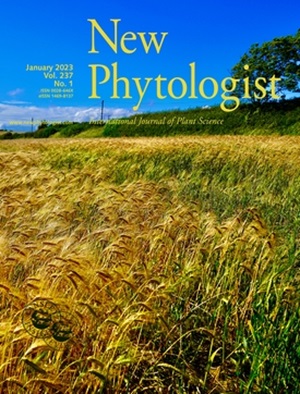Decades-old carbon reserves are widespread among tree species, constrained only by sapwood longevity
IF 8.3
1区 生物学
Q1 PLANT SCIENCES
引用次数: 0
Abstract
- Carbon reserves are distributed throughout plant cells allowing past photosynthesis to fuel current metabolism. In trees, comparing the radiocarbon (Δ14C) of reserves to the atmospheric bomb spike can trace reserve ages.
- We synthesized Δ14C observations of stem reserves in nine tree species, fitting a new process model of reserve building. We asked how the distribution, mixing, and turnover of reserves vary across trees and species. We also explored how stress (drought and aridity) and disturbance (fire and bark beetles) perturb reserves.
- Given sufficient sapwood, young (< 1 yr) and old (20–60+ yr) reserves were simultaneously present in single trees, including ‘prebomb’ reserves in two conifers. The process model suggested that most reserves are deeply mixed (30.2 ± 21.7 rings) and then respired (2.7 ± 3.5-yr turnover time). Disturbance strongly increased Δ14C mean ages of reserves (+15–35 yr), while drought and aridity effects on mixing and turnover were species-dependent. Fire recovery in Sequoia sempervirens also appears to involve previously unobserved outward mixing of old reserves.
- Deep mixing and rapid turnover indicate most photosynthate is rapidly metabolized. Yet ecological variation in reserve ages is enormous, perhaps driven by stress and disturbance. Across species, maximum reserve ages appear primarily constrained by sapwood longevity, and thus old reserves are probably widespread.
求助全文
约1分钟内获得全文
求助全文
来源期刊

New Phytologist
生物-植物科学
自引率
5.30%
发文量
728
期刊介绍:
New Phytologist is an international electronic journal published 24 times a year. It is owned by the New Phytologist Foundation, a non-profit-making charitable organization dedicated to promoting plant science. The journal publishes excellent, novel, rigorous, and timely research and scholarship in plant science and its applications. The articles cover topics in five sections: Physiology & Development, Environment, Interaction, Evolution, and Transformative Plant Biotechnology. These sections encompass intracellular processes, global environmental change, and encourage cross-disciplinary approaches. The journal recognizes the use of techniques from molecular and cell biology, functional genomics, modeling, and system-based approaches in plant science. Abstracting and Indexing Information for New Phytologist includes Academic Search, AgBiotech News & Information, Agroforestry Abstracts, Biochemistry & Biophysics Citation Index, Botanical Pesticides, CAB Abstracts®, Environment Index, Global Health, and Plant Breeding Abstracts, and others.
 求助内容:
求助内容: 应助结果提醒方式:
应助结果提醒方式:


